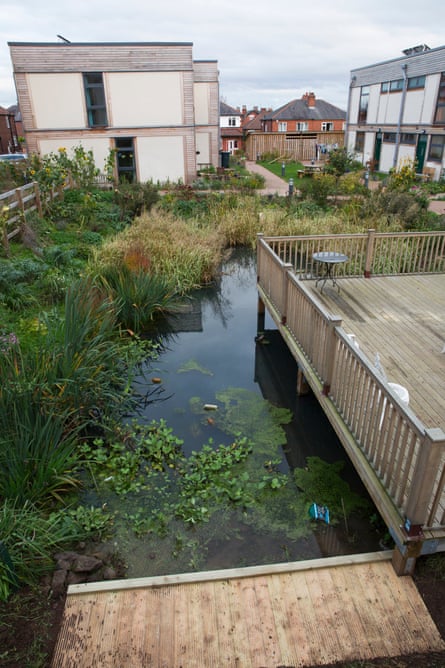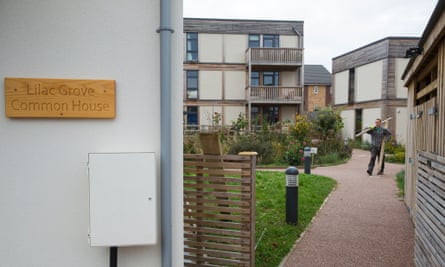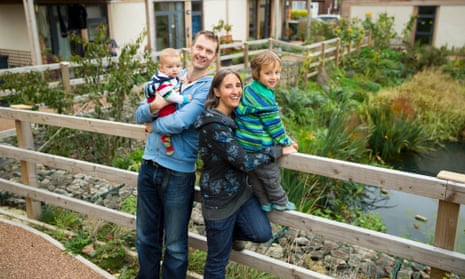In the early autumn sunshine, four-year-old Milo and his two playmates race between houses built of straw, in and out of open doors, grabbing an apple here and a drink there, occasionally slowing to greet an adult or poke the earth with a stick.
Unlike most youngsters growing up in modern cities, these boys’ lives combine unusual freedom and security. They and their families are part of a tiny but growing movement to build and develop new urban neighbourhoods, based on co-operative and sustainable living.
Milo lives with his parents, Paul Chatterton and Tash Gordon, and baby Rafi, in Lilac Grove in Leeds, a co-housing project of 35 adults and 10 children that has been up and running for 18 months after around six years of planning and construction. Its 20 individual, private housing units are grouped around a communal garden and courtyard, with shared facilities such as a laundry room, workshop, allotments and bike sheds. Central is a common house where residents meet, cook and eat together twice a week, hold parties, collect their mail, host local groups and collectively govern their little community.
Around 150 miles to the south, Freddie, another four-year-old boy, is awaiting a life like Milo’s. His parents, Nicola and John Leighton, are members of a co-housing group a few years behind Lilac. The Cambridge K1 project, comprising 40 families and individuals, expects to get outline planning permission for its site a few miles north of the city centre early next year. The embryonic community hopes to move into their new homes in the spring of 2016.

Like Lilac, the K1 project has been supported by the city council, and both are being viewed as potential models for urban housing developments in the future.
Co-housing originated in Denmark in the mid-1970s, and swiftly became established in Scandinavia, Germany and the US. A few co-housing communities have emerged in the UK over recent years, and the idea is now rapidly gaining momentum with more than 60 projects in the pipeline.
Jo Gooding, coordinator of the UK Co-housing Network, describes these projects as “self-managing communities, independently governed by the people who live there”. Members have private, self-contained homes, supplemented by communal facilities, such as a common house, playrooms, workspace, guest accommodation. Cars are ancillary, making communal spaces safe and pleasant.
“The design principles encourage social interaction,” she says. Co-housing is attractive to single people, especially in older age groups, who want to live neither in isolation nor in conventional senior housing, and to families looking for supportive environments in which to raise children and juggle work commitments. All groups and communities have a strong desire to collectively reduce their environmental footprint.
Gooding says there has been a 100% increase in groups forming in the past two years, and 18 projects have been completed, with “a definite trend towards cities” – including London, Cardiff, Newcastle, as well as Leeds and Cambridge. Local authority interest and involvement has also been picking up.
According to Stephen Hill, director of C2O futureplanners, co-housing projects are part of the building blocks of cities of the future. “We’ve lost the plot of how people want to live and how to adapt to social and environmental change. The accepted thinking is that we don’t really live in neighbourhoods any more. But actually people are desperate to feel they live in a place where they can relate to others, in a naturally protective environment that enables people to be more active citizens.”

This requires radical thinking from planners and developers, he says. “Those who provide housing have found ways of isolating themselves from people who need housing. The idea that you should engage directly with the people who are going to live in the homes you are planning or building is really alien.”
His view is echoed by Patrick Devlin, a London-based architect specialising in co-housing for older people. He says the UK housing model is “stuck” on a range with, at one end, commercial developers building homes without meaningful consultation; in the middle, housing associations “some of whom are smart enough to take feedback seriously”; and, at the other end, privately resourced individuals undertaking Grand Designs-type projects. In contrast, co-housing is “an intentional community, with shared interests, aspirations and ethics, that wants to leverage that into a physical space where the balance of privacy and communality is critical”.
Devlin has worked with the Older Women’s Co-housing Group, whose members hope to move into their north London properties by the end of next year. It is one of several groups aimed at people over 50 who want to remain in active control of their lives amid like-minded neighbours. As well as being an attractive alternative to retirement homes, such projects can have wider benefits to society as members of a mutually supportive community are likely to be less dependent on social and medical services.
In Leeds, the community is founded on sustainability and affordability. Lilac (an acronym of low-impact living affordable community) is built on the site of a former school in an unfashionable area of the city. Its buildings, constructed from timber, straw insulation and lime, communal gardens and shared facilities are in stark contrast to the surrounding rows of terraces and semis, but Lilac is keen to extend the hand of friendship, offering its neighbours several allotments, a “pocket park” and a meeting space for community groups.

The age of Lilac’s members runs from early 20s to over 80, and the housing units range from one-bedroom flats to four-bedroom houses. The 20 households share five washing machines in a communal laundry room and dozens of bikes, and between them own 10 cars – much lower than the 2011 national average of 1.2 cars per household – which are parked on the site’s periphery.
All the homes face into the gardens, though each has a small area of private outside space. A large decked terrace overhangs a pond which acts as a drainage system. Solar panels keep power costs at a minimum and provide a modest income which is used to fund the common house. Members cook a communal meal there twice a week; attendance is voluntary.
Lilac has a complicated ownership structure. All members buy shares in a mutual company which owns the site and properties, initially paying the equivalent of 10% of the value of their property. Thereafter they contribute 35% of their income, accruing more shares. If they want to leave Lilac, they sell the shares they own. All members are required to have some income.
“We’ve fundamentally changed the way people relate to their housing,” says co-founder and resident Paul Chatterton. “We do not see housing as a commodity on which you speculate. We’re making a stand against casino capitalism in the housing market. We want to be affordable in perpetuity.”
Each member is required to take an active part in the running of Lilac, joining at least one of nine “task teams” dealing with, for example, gardening, maintenance or finance and attending general meetings once a quarter to take decisions and set policy.
“This place is not immune to the real world, but we have processes in place to resolve problems and a commitment to sorting things out,” says Chatterton, who has just published a book about the Lilac project. The workload involved in running a self-managed neighbourhood is high, he says, “but it’s countered by a sense of security. We are our own landlords.”
The Lilac model is of great interest to the Cambridge K1 group, but their co-housing project will have a different financial structure. Each unit will be sold on a long lease at its market value, and the members’ company will own the freehold of the land. But there will be features in common with Lilac: a members’ house, communal gardens, cars kept to the periphery, a joint laundry. Other facilities are possible, depending on members’ wishes and the company’s resources: for example, a gym or a children’s playroom.
For Nicola Leighton, Freddie’s mother, the idea of co-housing is attractive. “To have a community aspect to your life, but to be able to shut your own door when you want to, really appeals to me. Being at home with a young child can be very isolating. To be able to go somewhere nearby without having to arrange a playdate will be great.”
Nicola and her husband John envisage a long-term commitment to building a community. She laughs off the suggestion of a potential goldfish bowl environment, saying members’ lives are bound to be spent as much outside the community – with friends and family and at work – as inside. She confesses to some worries about “endless meetings” although adds “it will be more fun to do the gardening with others than on my own”.

The K1 site was originally earmarked for development by a private housebuilding company, but the firm pulled out when the economy tanked in 2008. The city council cast around for a new buyer, considering social landlords and self-builders, before deciding to offer it for co-housing. “We saw it as an innovative way of bringing the site forward for development in a difficult market and creating a vibrant community,” says Dave Prinsep, head of property services at Cambridge City Council.
A deal was eventually hammered out with the K1 group – formally incorporated as Cambridge Co-housing Ltd – and construction is expected to begin next spring. Adam Broadway, a housing and planning expert who is helping to steer the project, acknowledges that some potential members may be priced out of the project, as one-bedroom flats are expected to sell at a minimum of £180,000 up to £450,000 for a four-bedroom house. “Prices have been a real struggle within the group; income is a challenge,” he says.
Prinsep is simultaneously enthusiastic and cautious about co-housing. “I’d love to say this is the way ahead. There is clearly demand, it builds a strong sense of community and high levels of sustainability. But it’s work in progress. We will need to reassess, to see if it works.”
Issues of trust and financial viability have to be hammered out within co-housing groups, says Gooding. The timeframe is also a factor. In the UK, the average period between securing a site and moving in is three to four years – twice that of the US – but that could be reduced with good professional input from local authorities, she says.
“We have to come up with solutions of how we live as a society. Loneliness is said to be as big a health risk as smoking. The intergenerational benefits of co-housing are huge. It’s not for everyone, but for those who want to know their neighbours, it’s a good model.”
According to Devlin, co-housing will only really take off once there is a critical mass of successful schemes. “Then we will be able to say to planners and councils: here is a motor of social integration and development, which we need to drive forward. How are you going to facilitate this?”
Back in Leeds, the members of Lilac see their community as prototype. “Our ambition is to have 20 projects in the Leeds area over the next 10 years, housing 3,000 people,” says Chatterton, estimating such a plan needs £100m investment. But their ambition does not stop at the Leeds boundary. “We’d like to have thousands of little Lilacs all over the country.”
- Low Impact Living: A field guide to ecological, affordable community building by Paul Chatterton, a founder of Lilac, is available for £26.99 including free P&P at bookshop.theguardian.com or by calling 0330 333 6846.

Comments (…)
Sign in or create your Guardian account to join the discussion